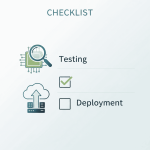Introduction
Building a MERN stack application (MongoDB, Express, React, Node.js) is just the beginning — testing is what ensures your app works reliably in real-world scenarios. Testing allows you to catch bugs early, improve performance, and deliver a better user experience.
In this article, we’ll walk through a step-by-step approach to testing a MERN stack application, covering everything from unit tests to end-to-end testing.
1. Set Up Your Testing Environment
Before writing tests, install essential testing libraries:
- Jest – Unit testing framework.
- Supertest – For API endpoint testing in Express.
- React Testing Library – For testing React components.
Example installation:
npm install --save-dev jest supertest @testing-library/react
2. Write Unit Tests for Backend (Node.js + Express)
Unit tests focus on individual functions and modules.
Example test for a service function:
test('should return correct sum', () => {
const result = addNumbers(2, 3);
expect(result).toBe(5);
});
Benefits:
- Ensures logic works as expected.
- Easy to debug failures.
3. Test API Endpoints
Use Supertest to simulate API calls and verify responses:
const request = require('supertest');
const app = require('../app');
test('GET /api/users should return users list', async () => {
const res = await request(app).get('/api/users');
expect(res.statusCode).toBe(200);
expect(res.body).toHaveProperty('users');
});
4. Test React Components
React Testing Library makes sure your UI behaves as expected:
import { render, screen } from '@testing-library/react';
import Login from './Login';
test('renders login button', () => {
render(<Login />);
expect(screen.getByText(/Login/i)).toBeInTheDocument();
});
Benefits:
- Verifies that buttons, forms, and user flows render correctly.
- Ensures consistent UI behavior after code changes.
5. Integration Testing
Test how multiple parts of the app work together:
- API + Database integration.
- Frontend + Backend communication.
This ensures the entire flow works, not just individual parts.
6. End-to-End (E2E) Testing
Use tools like Cypress or Playwright for real-world simulation:
- Simulate user clicking buttons, filling forms, submitting data.
- Validate results are reflected in the database.
7. Automate Testing in CI/CD Pipeline
Integrate tests into your CI/CD (GitHub Actions, GitLab CI, Jenkins):
- Run tests automatically on every push.
- Block deployments if tests fail.
8. Monitor and Refactor
- Review test coverage reports.
- Update tests whenever you add new features or fix bugs.
Conclusion
A well-tested MERN stack application leads to fewer bugs in production, happier users, and lower maintenance costs. By following this step-by-step guide, you’ll ensure your application is stable, scalable, and ready for real-world usage.
👉 Need help setting up a test strategy for your MERN stack app? At Redirect India, we provide end-to-end testing and deployment services. Reach out and let’s make your application rock-solid.
